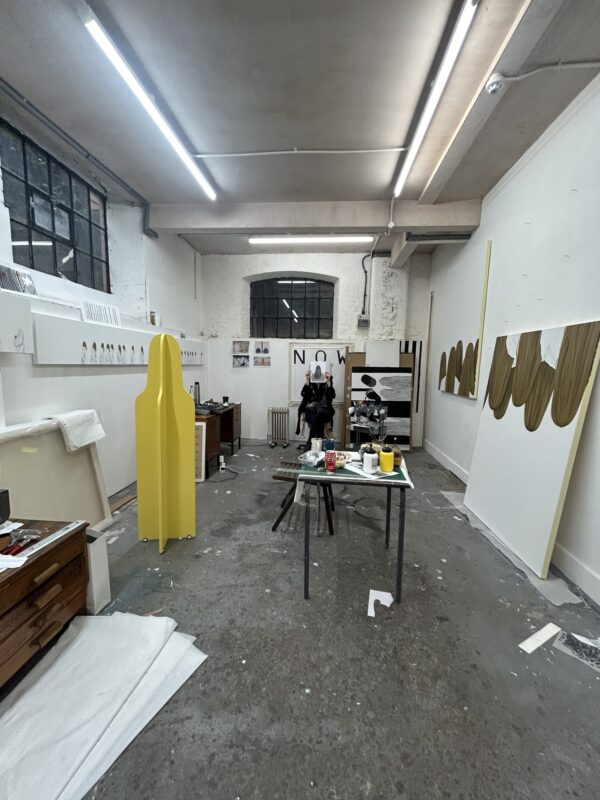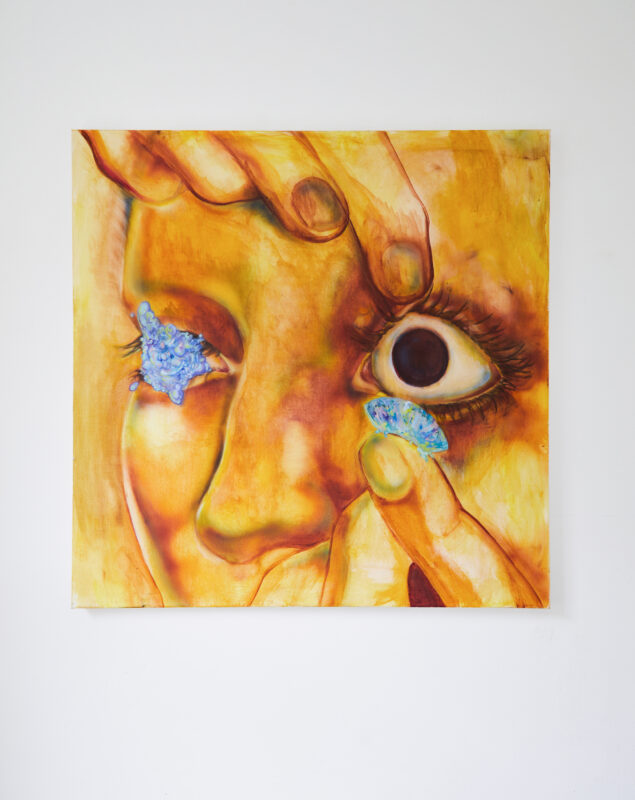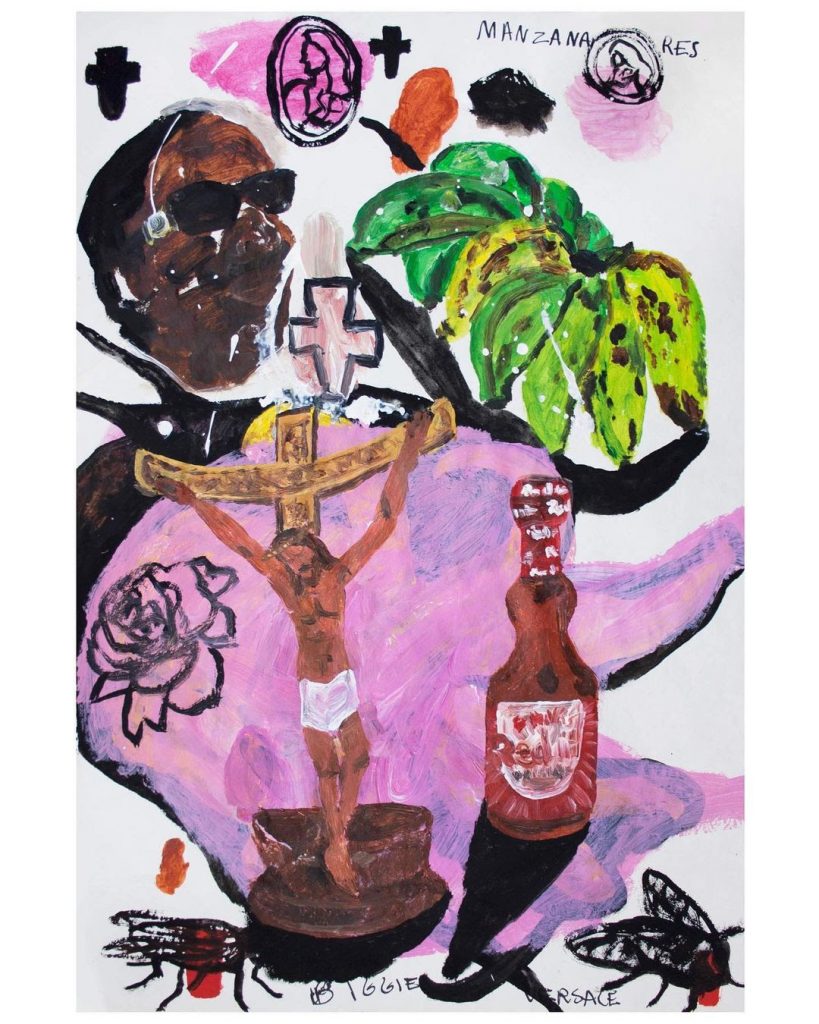
The first swing of the bat pulls together a broad collection of language and conceptual framework, each artist bringing a distinct language to the show. The exhibiting artists primarily work with paint, sculpture, collage, drawing and printmaking also play in a role. Certain types of realism hover at the precipice of abstraction, amalgamations of the unreal and hyperreal collide, there is tension sought between these languages and their relationship to time. There are slight overlaps of interest but for the most part each artists agenda is solitary, ten islands to visit. The ambition of this show is to present an ariel view of painting now. History ebbs through the show, folkloric, medieval narratives, whether the mythical is addressed in a graphic, digital language or sensual formalism, the everyday physically buried in gesture or meticulously considered in naturalistic tendencies.
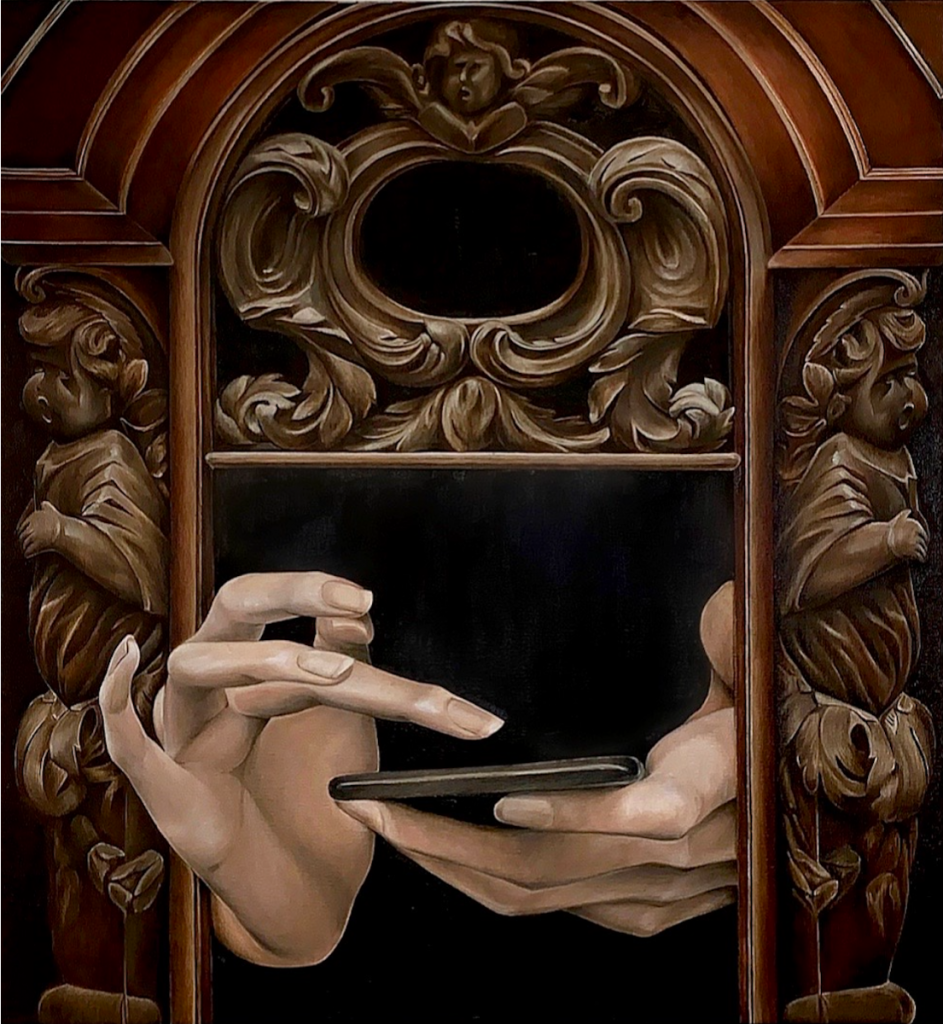
A low hum, the sun hanging high, a full carpark, a seemingly endless sea of radio fuzz, groggy eyes, long drives, tens of thousands of pilgrimages, collective expectations and escape.
The first swing of the bat alludes to a tight grip, bat in hand, and the moments before the batter swings, the tension, suspense and release of these nanoseconds. The ritualistic nature of honing skills in anticipation of performance and the zones occupied in two states is a thread not dissimilar to that found in any studio. The palpable, tangible excitement of a long awaited event, a thread reproduced endlessly in cinema and literature. The introduction to Don Delillo’s Underworld and Takeshi Kitano’s Boiling Point each contributed to the conception of the show. Delillo’s minute description of the excitement coupled with Kitano’s absurd nostalgic odyssey, subverting the banal, unrolling untold events. Visual equivalents have been sought to mirror the tension, malleability, elasticity and scale cited in Delillo and Kitano’s narratives.
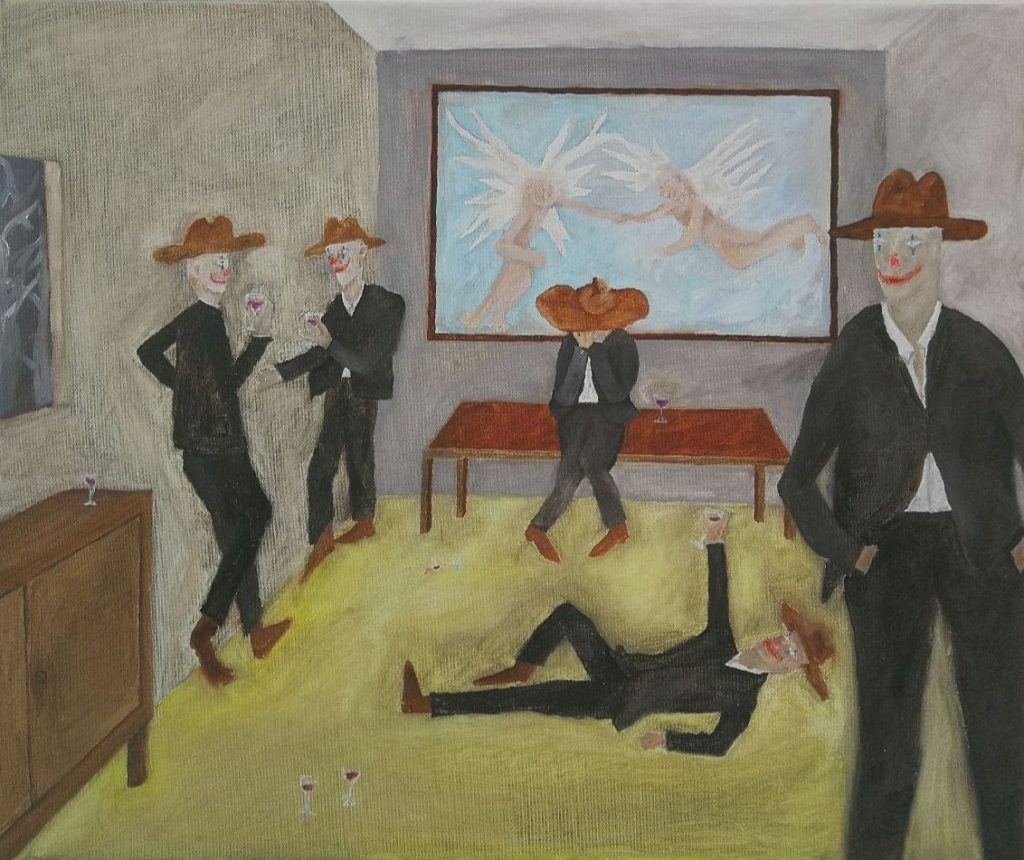
‘The first swing of the bat’ Curated by GALLERY46 & Paint Talk – WEDNESDAY 28th APRIL 2021 LATE NIGHT THIS FRIDAY BOOK
Featuring artists:
Ned Armstrong
Max Gimson
Ariane Heloise Hughes
Sophie Lourdes Knight
Viktor Mattsson
Holly Mills
Jade Ching-yuk Ng
Daniel Taylor
Heidi Ukkonen
Maïa Régis
NED ARMSTRONG(b. 1992) lives and works in London. Recent exhibitions include Glass Houses, Mcbeans Orchid Nursery, Lewes, The Jester’s Pool, Hrisey, Iceland; Conveyor, Morgan Fine Arts, New York; All Over, Middlesex Presents, London; Summer Exhibition, Royal Academy of Art, London; Post, Edinburgh College of Art, Edinburgh; Places I Want To Be, P.S. Mirabel Gallery, Manchester; Stuffstarts, New Glasgow Society, Glasgow and Fresh Air/Hot Sauce, Arbyte Studios, London. He has been awarded the George Jackson Prize, the Andelli Prize and the Edinburgh College of Art Studio award. He has recently completed the Turps Studio Programme, and is included in this year’s New Contemporaries at the South London Gallery. “My recent work depicts a mist covered sea space made of small pointillist like dots. The painstaking building up of the marks creating an imaginative space from which fantastical forms emerge. Building up the painting, thoughts and forms gather slowly and intuitively, the process one of conversation. From the flickering light, bodies and volumes emerge like forms from clouds. The final works presenting a frictionless utopian space of heavenly fantasy where whales drift through the flows, like modern machines stalking the depths. This approach emerged from working with collage to make small, jewel like canvases. These paintings were pushed and picked at, detritus torn from one painting placed onto the body of another. The rips and marks imbued with an anxious and searching quality, made manifest through repetition and a kind of pushing out against the edges of the picture plane. Through these actions, the paintings became containers showing off the marks and spaces made, with the material becoming at once base and emotionally charged.”
MAX GIMSON (b. 1990) studied at Brighton University between 2009-2012 his BA in Fine Art Painting and recently graduated from the Royal College of Art with a Master’s degree in Painting in 2019. Gimson currently work and live in Glasgow, UK. “The ongoing interrogation present in my work is a ‘feeling out’ of my surroundings, and of the material and visual qualities specific to the medium of paint. It is a process of being led by the incidental nature of painterly mark making until a surprising combination of subject matter and form is revealed. Most recently the work is situated in the mechanics of automatic thought, procrastination and mild fatigue. The paintings are tethered loosely to autobiographical and industrial archetypes such as fences, barbed wire and batteries as well as certain placeholders for the psyche, such as the “self portrait” and references to Gilbert’s syndrome, both narratively and materially.”
ARIANE HELOISE HUGHES (b. 1997) is a British/Australian painter based in London. “I’ve had a long infatuation with oils and if I had to, would define my work as figurative with a very surrealist undertone. I graduated from my BA painting course at Camberwell, 2019 & then spent almost a year making working and assisting sculptor Dario Ghibaudo in Milan. I currently have a space with VO Curations in Aldgate and spend most (if not all) of my time in the studio covered in paint. Hughes’ paintings navigate the tenuous threshold of the subject/object dichotomy. Since its formal conception by Descartes this dualistic way of considering being has coloured much of Western thought. Through her blending of contemporary and traditional imagery, amalgamation of figuration and setting, Ariane challenges this rigid paradigm. Humans have the tendency to compartmentalise things, oversimplifying the world in an attempt to comprehend the nature of existence. But personhood isn’t so tidy. The ambiguity of existence inherent to the human condition is palpable throughout Ariane’s work. No entire body remains intact, perspectives are warped and scales exaggerated.The surrealist undertones augment this apprehension. Unwittingly familiar yet eerily bizarre, Ariane plays on either side of the fine line between the mundane and the surreal. The depiction of the female nude in the Western Canon personifies the subject/object dualism. Ariane is fascinated by this and attempts to engage with this traditional trope devoid of objectification. Through her sensitive use of symbolism and appeal to the haptic senses, in the smoothness of her painted surface and reference to hands, Ariane hopes to conceive of a new visual vernacular for desire. One that operates outside the norms of conventional beauty and ‘the gaze’.”
SOPHIE LOURDES KNIGHT (b. 1992) is a multidisciplinary artist from California, USA working in painting, drawing, sculpture, and photography. She received a BFA in Painting & Drawing from California College of the Arts, 2014. She currently lives and works in London, UK where she is an MFA candidate at the Slade School of Fine Art. She is a Elizabeth Greenshields Foundation awardee, 2019 and 2020.
Within the studio, Sophie’s core interests revolve around notions of failure and ideas of what success could be, attempting to overcome ‘failure’ by making and remaking; failure as success, as subject, as object. She considers her practice to be multidisciplinary, using photography and sculpture as painting aides and accomplices. Subject matter is constructed with loose characters and objects inhabiting barren interiors and exteriors in an exploration of familiarity, sentiment, and the bizarre.
VIKTOR MATTSSON (b. 1988) lives and works in Umeå, Sweden. He has a MFA from Umeå Academy of Fine Arts. Mattsson’s artistic practice involves painting, drawing and tattooing. His works are executed in a naive aesthetic, with simple and clear imagery. Common themes of his works are vanity, shallowness and the struggle between good and bad. Mattsson often uses traditional characters and metaphors like demons, angels, snakes, cowboys and clowns. The subjects of his works are often depicted in a struggling state (i.e. fighting with the devil, being harassed by a snake). He likes to use classic subjects and stories, sometimes the imagery of his work is almost cliché. The main focus of Mattssons work is the poetic outcome of the story of the paintings and drawings.
HOLLY MILLS (b. 1990) lives and works in London. Mills graduated from The Drawing Year in 2018 and had previously studied at Camberwell College of Arts, winning the V&A Student Illustrator of the Year award in 2012. Selected exhibitions include TBW Drawing Prize 2020 (multiple locations, UK), Tickle Torture and Contemporary Visions VII(Beers, London) and The Pictionary Individual(Real Pain Fine Arts, Los Angeles). Mills’ (often small scale) mixed media works begin life as a visceral reaction to both text and lived experience. Often based on a very physical experience of place, her automatic, meditative approach to making results in recollections that live totally in the present. Mills’s desire to explore the mystery of memory and to use this to weave new narratives permeates much of her work. Often returning to familiar images and motifs, Holly’s visual manifestations are never static. Mills creates conscious dreamscapes in which weather is language and bodies intertwine with rolling hills, each work showing one moment of a wider narrative.
JADE CHING-YUK NG (b. 1992) is currently based in London. She is an interdisciplinary artist who is a BA graduate of the Slade School of Fine Art in 2016 and completed her MA printmaking course at the Royal College of Art in 2018. She stayed in Jerusalem for four months in 2014 for her exchange at Bezalel Academy of Art and Design. She is a recipient of Cass Art Painting Prize in 2016, Travers Smith Art Award in 2018 and Abbey Major Painting Scholarship in 2018 at the British School at Rome. She exhibited at San Mei Gallery, Cornucopia Gallery, Whitechapel 46, Canal Mills Armley, Siegfried Contemporary, Assembly Point, British School At Rome, Academia Di Romania a Roma, the Horse Hospital and CGP Gallery.Some of her works are currently in a private collection owned by the chair of Penguin Random House.
Her soft, intricate works emboss the fragility of a physical intimate relationship between herself and others. Jade is interested in quoting the essence of touch and separation at a moment in time. By exploring the possibilities of forms in painting, Jade conceives of her paintings as an assembly of her and others’ body puzzles. Often revolving around personal travel experience, classical myth, alchemy, religious rituals and anatomy as references, Jade deconstructs their symbolism by attaching her own interpretation, and her symbols seem to depart from their literal connotations into an obscure and ambiguous fiction. The agency of framing becomes a gesture of embracing, defining actual and pictorial surrealistic space. The essence of modernist architecture influences how she constructs and adds odds to her composition in the picture. She develops them into printmaking, painting, sculptural painting and the most recent cut-outs. Its theatricality encourages visitors to consider characters that are depicted in dialogue with themselves, whilst also considering the fine edge of collision in reality and imagination.
DANIEL TAYLOR (b. 1986) lives and works in London, UK. Taylor graduated with a BA in Intermedia / Sculpture from NSCAD in Halifax, Nova Scotia in 2014. Previous exhibitions include Going to the Pictures at SET, London, UK(2019); Silk Hat Man at AIRY, Kofu, JP (2019); Turned into What!? at 650mahhh, Hove, UK(2019) and upcoming at Ginsburg Gallery, Lima, Peru(2021).
“I work mainly in drawing and sculpture, using styrofoam and papier mache. My work is semi autobiographical and off-center. I try to find themes and patterns in the confusing, unremarkable moments in hopes of some sort of revelation. I’m interested in movies, music, and animation and I like to employ tropes and techniques from those fields to describe my own experience and create a familiar narrative from an unusual perspective.”
HEIDI UKKONEN (b. 1980) lives and works in Antwerp, Belgium. She studied at The Royal Academy of Fine Art Antwerp. The paintings by Heidi Ukkonen explores themes of the mundane such as relationships, anguish and suffering . These depictions are represented through playfully deformed animations within the life of modern society. Her works are built using materials such as acrylic, oil paint and spray paint which adds and builds texture to her works. Most of her inspiration derives from her life living in the vibrant city of Antwerp where she has worked since graduating from the Royal Academy of Fine Arts. Her thought process begins towards the end of each day and through trial and error, explosive, colourful and humorous works are brought about. Drawing knowledge and inspiration of the works of Philip Guston, Henri Matisse and Hieronymus Bosch she aims to bring her audience into a world where the usual becomes unusual , where the ugly becomes beautiful and where pain becomes humour.
MAÏA RÉGIS (b. 1995) is based in London, and graduated from an MA Painting at the Royal College of Art in 2019. Resident at Elephant Lab in 2019. Featured in Bloomberg New Contemporaries2017 and 2018.
“I want to impregnate my paintings with tactile sensations, smells, noises, so as to suggest fragments of stories forming a fictional narrative. In this sense, I pay as much attention to the chosen motifs as on the quality of the surfaces on which I work. Drawings scribbled on a wall, ex-voto, profiles of characters inspired from popular culture… ostensibly figurative subjects are associated with abstract geometric or organic patterns, producing a telescoping effect to complexify its reading. I also want my paintings to have an open, unfinished aspect: drawings in the form of a sketch, saturations or gaps, empty surfaces…
Keeping the freedom to act until the end, I must be able to change almost everything until the last minute. In this sense, a figuration too realistic or too neat would be a limitation for me. I like to navigate in these troubled waters, in a sort of surreal world, where the darkness flirts with flashing brilliance. My work tries to restore this rough and spontaneous world in a pictorial language far from all sophistication and mannerism.”


